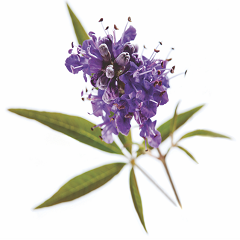
Medicine:
Use: taken orally during menstrual cycle
Vitex agnus-castus, also called chaste tree (or chastetree), is a native of the Mediterranean region. It is one of the few temperate-zone species of Vitex, which is on the whole a genus of tropical and sub-tropical flowering plants. It has been long believed to be an anaphrodisiac – leading to its name as chaste tree – but its effectiveness for such action remains unproven. Vitex is a cross-pollinating plant, but its self-pollination has been recorded.
Vitex agnus-castus is widely cultivated in warm temperate and subtropical regions for its delicate-textured aromatic foliage and butterfly-attracting mid-summer spikes of lavender flowers opening in late summer in cooler climates. It grows to a height of 1–5 m. It requires full sun though tolerating partial shade, along with well-drained soil. Under ideal conditions it is hardy to −23 °C (−9 °F) USDA Zone 6. In colder zones, the plant tends to die back to the ground, but as it flowers on new wood, flowering not affected on vigorous growth in the following season. This plant is a brackish water dweller, indicating that it tolerates salt. Cold and wet weather results in dieback and losses. The plant grows well on loamy neutral to alkaline soil.
Flavonoids (vitexin, casticin), iridoid glycoside (agnuside, aucubin), p-hydroxybenzoic acid, alkaloids, essential oils, fatty oils, diterpenoids and steroids have been identified in the chemical analysis of Vitex agnus-castus. They occur in the fruits and in the leaves. Essential oils have been found in the fruits and in the leaves. The oil of leaves, unripe and ripe fruits differ in compounds.
Vitex agnus-castus is commonly taken by mouth for conditions related to the menstrual cycle such as premenstrual syndrome and a more severe form called premenstrual dysphoric disorder. It is also used for "lumpy" breasts and and many other conditions.
Vitex agnus-castus seems to affect many hormones that are involved in women's reproductive cycle.